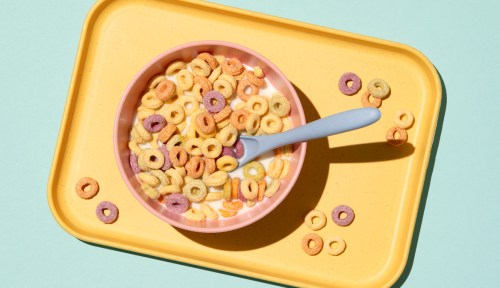Public school students in California will no longer be served foods with red dye No. 40 or five other chemicals, thanks to a bill signed by Governor Gavin Newsom. It’s the first state in the country to pass a law that bans certain ingredients that are often found in cereal, ice cream, candy, snacks, and other processed foods.
Experts in This Article
integrative and functional dietitian with Top Nutrition Coaching
The law is known as the California School Food Safety Act, and it prohibits California public schools from providing foods or drinks that contain red dye No. 40, yellow dyes Nos. 5 and 6, blue dyes Nos. 1 and 2, and green dye No. 3. The new law will go into effect on December 31, 2027.
The bill was introduced by Democratic Assemblymember Jesse Gabriel, targeting synthetic food dyes that can potentially harm kids. According to a 2021 study by the California Office of Environmental Health Hazard Assessment, food chemicals have been linked to behavioral challenges and trouble concentrating among children.
Here, a registered dietitian explains how harmful these chemicals really are.
How worried should we really be about food dye?
Considering the research that drove California to ban food dyes from its school system, staying mindful of food dyes and their health implications on humans is important, says Tami Best, RDN, an integrative and functional registered dietitian with Top Nutrition Coaching.
“They are used in an abundance of products across many different aisles. They are even used in foods marketed as health foods,” Best says.
“The reality is, when we are speaking about a healthy diet, especially a healthy diet for children for their growth and development, our aim is to promote a whole-foods diet. A whole-foods diet is a diet with minimal processing, where foods that are eaten come from the earth. Food that is eaten in its natural, unprocessed form does not have artificial dyes added to it.”
Best also warns that manufacturers often use food dyes to make food products more appealing to children.
“In a way, they are manipulative. With their bright colors they are enticing children to consume the food item which most often fits into the category of ultra-processed foods,” she says.
According to a June 2024 study in Nutrition Reviews, researchers found a connection between ultra-processed foods and children having obesity and other cardiometabolic conditions like diabetes.
How much artificial food dye is safe to eat?
Currently there are no guidelines on how much artificial food dyes are considered safe, Best says.
“My recommendation is to limit intake of food products containing these [chemical] dyes. Safe dyes are ones that are created from plant foods such as carrots, currants, beets, and berries,” she says.
To be more aware of what you’re eating, you can look at a food’s ingredient label. And keep in mind, Best says, that the more processed a food is, the more likely it is to contain ingredients like chemical dyes.
While artificial food dyes don’t provide any nutritional benefits, it doesn’t mean they have to be avoided entirely. Best says she approaches ultra-processed foods as “treat foods” that can still be included in a mostly whole-foods diet.
“We have a long way to go to help all children be empowered to make similar balanced choices,” she says. “Artificially dyed and highly processed foods need to become less available and accessible while whole foods created from real foods become the rage.”
Evgenia Petridi, Kalliopi Karatzi, Emmanuella Magriplis, Evelina Charidemou, Elena Philippou, Antonis Zampelas, The impact of ultra-processed foods on obesity and cardiometabolic comorbidities in children and adolescents: a systematic review, Nutrition Reviews, Volume 82, Issue 7, July 2024, Pages 913–928, https://doi.org/10.1093/nutrit/nuad095
↩︎
Sign Up for Our Daily Newsletter
Get all the latest in wellness, trends, food, fitness, beauty, and more delivered right to your inbox.
Got it, you've been added to our email list.











